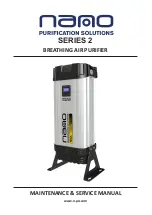
Page 12
Note: The air coil should be thoroughly washed with a
filming agent, (dishwasher detergent, Cascade). To help
condensate drainage. Apply a 20 to 1 solution of Cascade
and water, spray both sides of coil. Repeat and rinse
thoroughly with water.
The TXV can be braze into place as shown keeping the
'IN' side toward the outdoor GT-S unit. The TXV has
an
internal check valve and must be installed in the proper
direction for operation. Always keep the valve body cool
during brazing to prevent damage to the TXV. When
attaching the equalizer flare always lubricate with a small
amount of refrigerant oil to prevent leaks. Attach the bulb
to the suction line using the supplied hose clamp.
Be
careful not to overtighten the clamp and deform the
bulb.
Installing the Lineset to GT-S Unit
Braze line set to the service valve stubs on the front of
the GT-S cabinet as shown in Figure 8. On installations
with long line sets, copper adapters may be needed to
connect the larger diameter tube to the stubs. Nitrogen is
to be bled through the system at 2 - 3 psi to prevent
oxidation contamination. Use a low silver phon-copper
braze alloy on all brazed connections. GT-S cabinets are
shipped with a factory charge and service valves are not
to be opened until the line set has been leak tested,
purged and evacuated. See Charging the System.
Evacuation and Charging the Unit
LEAK TESTING- The refrigeration line set must be
pressurized and checked for leaks before purging and
charging the unit. To pressurize the line set, attach
refrigerant gauges to the service ports and add refrigerant
R-22 or an inert gas (nitrogen or dry carbon dioxide)
until pressure reaches 60 - 90 psig. Never use oxygen or
acetylene to pressure test. Use a halogen leak tester or a
good quality bubble solution to detect leaks on all
connections made in the field. Check the service valve
ports and stem for leaks. If a leak is found repair it and
repeat the above steps. For safety reasons do not
pressurize system above 150 psig. System is now ready
for processing and charging.
EVACUATION OF THE LINESET AND COIL- The
line set and coil must be evacuated to at least 200
microns to remove any moisture and noncondensables.
Evacuate the system through both service ports in the
shipping position (full CW in) to prevent false readings
on the gauge because of pressure drop through service
ports. The system is now ready for charging.
CHARGING THE GT-S SYSTEM - There are two
methods of charging a refrigerant system. One method is
the total charge method, where the volume of the system
is determined and the refrigerant is measured and added
into the evacuated system. The other method is the partial
charge method where a small initial charge is added to an
evacuated system, and remaining refrigerant added
during operation.
TOTAL CHARGE METHOD - See Table 2 for the basic
charge of GT-S units. For line sets with 3/8'’ liquid lines
add 0.6 ounces of refrigerant to the basic charge for
every installed foot of liquid line. Add 1.2 oz. per foot if
using l/2'’ line. Once the total charge is determined, the
factory pre-charge (Table 2) is subtracted and the
remainder is the amount needed to be added to the
system. This method should only be used when using the
ARI matched air handler.
EXAMPLE
: Model GT-S P48 with 40 feet of installed
liquid line (3/8” O.D.). The basic charge of GT-S P48 is
115 oz.. plus 29oz. of liquid line x 0.58 oz. per ft. =115 +
24 =139 oz. (Total Charge). The GT-S is shipped from
the factory with 130 oz. of refrigerant (for 25ft lineset),so
the amount you would add is 139 - 130 = 9 oz.
Turn service valves full out CCW and then turn back in
1/2 turn to open service ports. Add the required
refrigerant so that the total charge calculated for the unit
and line set is now in the system. Open the service valve
fully counterclockwise so that the stem will backseat and
prevent leakage through the schrader port while it is not
in use. Start unit in the heating mode and measure
Heating
Cooling
EWT (°F)
SuperHeat
SubCooling
(using LL
Pressure)
SubCooling (using
Discharge
Pressure)
SuperHeat
SubCooling
(using LL
Pressure)
SubCooling
(using Discharge
Pressure)
3 0
5-10
5-9
8-12
12-18
12-22
15-25
5 0
9-12
5-9
8-12
10-15
9-16
12-18
7 0
10-14
3-7
6-10
10-15
7-12
10-15
9 0
-
-
-
8-12
7-12
10-15
1 1 0
-
-
-
8-10
7-11
10-14
These numbers are guidlines for charging only and differences of 3 deg or less are acceptable
Table 6. GT-S Charging Values













































